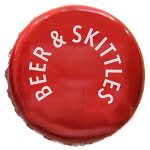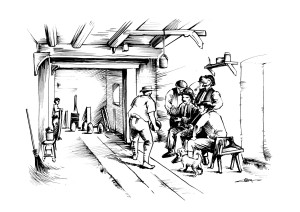The Globe, Military Road was first fully licensed in 1834 and probably existed as a Beer House in 1830. In 1838 it was put on the market and sold after landlord John Wheeler emigrated to Canada. At that time the Globe consisted of two parlours, a bar, a tap room, four bedrooms to let and a skittle alley at the rear.
In its early days the Globe was used by men employed on the maintenance of the Royal Military Canal, which flows nearby and after which Military Road is named. A sketch map of the canal from the 1830s shows the Globe as an isolated building in a totally rural setting.
By the 1870s adjacent outbuildings had become a forge and a blacksmith’s shop, later known as Sutton’s Forge, demolished after the First World War. Stables were established at the back alongside the ever popular and now larger skittle alley.
The other feature of the Globe was the old cave in the cliff face used as the pub cellar. The Globe cave became a feature in Rye’s official guide books published by Adams throughout the 1930s.
The game of skittles played here from the 1830s to the 1870s was a popular version known as Four Corners. Many customers spent all day here playing the game which consisted of four skittles or pins, instead of the more common nine pins, positioned using a square wooden frame. The game required the hurling of a large wooden bowl, known as a “cheese”.
The cheese was made from lignum vitae, a very heavy American hardwood weighing between four and six pounds (three kilos). It required great physical strength on the part of the players. The cheese was thrown at the four pins from a distance of about ten feet (three metres). 
Because of the space required, Four Corners was always played in a special shed or alley at the rear of the pub. Regular games were played against visiting customers from other pubs such as the Crown, Ferry Road and the Queen’s Head in Landgate.
By the 1870s the game of Four Corners had gone out of fashion and had been replaced with the more traditional game using nine pins in three rows of three.
The Pubs of Rye, 1750-1950 by David Russell is available from The Rye Bookshop, 25 High Street, the Heritage Centre, Strand Quay; Adams, 9 High Street; or online . Other books by David Russell are The Pubs of Hastings & St Leonards, The Pubs of Lewes, The Swan, Hastings and Register of Licensees for Hastings & St Leonards.
Photos: supplied by David Russell



